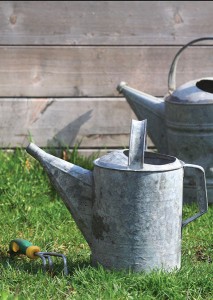Summer pretty much wraps up at the end of this month. Until then, enjoy the fruits of your labor and continue to care for your gardens and flowerbeds, picking vegetables and removing annuals that are no longer thriving.
Clear out plants
Do you have vegetables that are done for the season? Remove them now. If you started other annuals or perennials in July, you can plant those in their place.
If you notice that plants seem overcrowded, consider dividing them to give the plants more room. Or, if a plant isn’t flowering as much as it once did or if it’s center has died, you will want to divide the plants.
Plants you’ve removed from your garden can be added to your compost bin. Make sure they aren’t diseased or infested with insects. As long as your lawn hasn’t been treated by herbicides, you can add grass clippings to your compost bin, too.
Continue watering

Farm and Dairy online columnist Ivory Harlow explains that if plants have brown leaves, are wilted, grow slowly or produce poor quality, stringy vegetables, they’ve likely received too much water.
Insects and harvesting
Pests and diseases are still problems even this late in the summer gardening season. When harvesting, pay close attention to fruits and vegetables. When picking fruits and vegetables affected by insects, be sure to remove damaged parts before cooking and eating. Make sure fruits and vegetables are clear of insect eggs before bringing them inside.
Collect seeds to save
Saving seeds from your garden is a great way to save money on purchasing new seeds in the spring. It’s also a fun way to keep the plants you love and decide which plant characteristics you want to preserve from your current garden to cultivate the following year. Seeds should only be saved from plants that are not hybrid.

Propagation
One way to keep perennial plants you love is by propagating by stem cuttings. University of Nebraska-Lincoln Extension in Lancaster County explains how to propagate geraniums and coleus with the correct supplies and techniques. Purdue University Cooperative Extension goes into further detail about propagation, such as the different types of cuttings and how to make those cuttings.
Plan for your fall garden
The growing season doesn’t have to end when summer does. Crops like collards, garlic, beets, carrots, lettuce and radishes can all be planted in August for a fall or spring crop.
Farm and Dairy online columnist Ivory Harlow is a seasoned fall planter. She lists 10 examples of cool weather crops that can be planted this fall and harvested before winter sets in or in the spring.
If you want to improve your soil for next spring’s planting, consider planting a cover crop this fall. Cover crops feed the soil. They also improve soil structure, which helps to prevent erosion and compaction. Cover crops add depleted nutrients back into the soil, such as nitrogen, and they also help to cut down on weeds.
10 more gardening posts:
- September’s gardening to-do list Sept. 4, 2015
- Overwintering garlic July 31, 2015
- How to manage common garden problems July 20, 2015
- Keepin’ it fresh: How to store garden produce July 10, 2015
- How to manage your garden after too much rain June 23, 2015
- Grow more with less: Cut and grow-again garden vegetables June 19, 2015
- Water your vegetable garden for optimal performance May 22, 2015
- How to manage insects in the garden May 12, 2015
- If weeds could talk April 24, 2015
- How to keep wildlife out of your garden April 14, 2015











